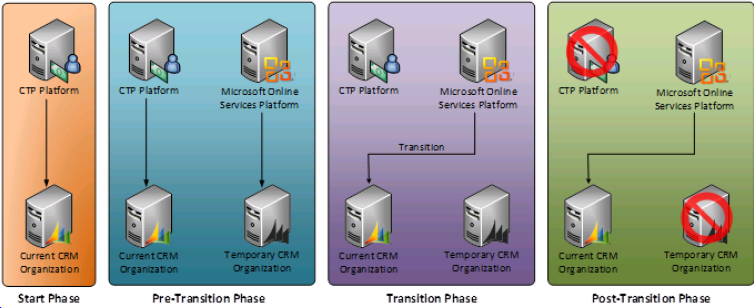Phases and Requirements during transition of your CRM Online organisation
On July 19th, 2012 Microsoft Dynamics CRM Online on-boarded to a new administration portal and billing platform. Together the portal and billing platform are referred to as the Microsoft online services environment. This environment is designed to streamline and improve the customer experience across all Microsoft online services. It enables customers to manage their Microsoft Dynamics CRM Online and Office 365 subscriptions from one location and also delivers enhanced regulatory and industry compliance.
Prior to the introduction of this environment, customers who created a subscription using Microsoft Dynamics CRM Online used a different administration portal and billing platform. For the purposes of this blog post, this legacy platform will be referred to as CTP (Commerce Transaction Platform). This original platform for the service will be decommissioned in the Q4 2013 timeframe, and customers will be moved to Microsoft’s standard administration, billing and provisioning environment for cloud services (the Microsoft online services environment).
Microsoft will not be physically moving your organization application or data. At no time during the transition does Microsoft move your actual Microsoft Dynamics CRM organization comprising your application and data. Your Microsoft Dynamics CRM organization remains on the same physical online infrastructure (e.g. scale group) before and after the transition. The transition is concerned with the implementation of a new authentication mechanism and administration portal, which during the transition is connected to your existing Microsoft Dynamics CRM organization. The diagram below shows the key stages in the transition process.
Start Phase
- The current situation where administration and billing of your organization is managed through the CTP platform and where we ask you to perform certain preparation activities
Pre-Transition Phase
- Microsoft advises that Pre-Transition activities be started weeks in advance of the scheduled transition date.
- The transition of service will have an impact on users, developers and administrators of Microsoft Dynamics CRM; therefore it requires a level of planning equivalent to any major technology infrastructure change.
- During the Pre-Transition Phase, your Transition Manager (see the Transition Center for more) will set up a Microsoft Dynamics CRM Online trial account on the Microsoft online services environment for your organization. Once this account is created, you will have access to your CRM Online solution on the Microsoft online services environment through this trial account.
- IMPORTANT: Once your trial account has been established on the Microsoft online services environment, you will need to activate your licensing and billing before you can transition.
- You should not add new users during the Pre-Transition phase.
Transition Phase
- The transition will be performed. During this time your organization is still accessible in a Read-only mode until the transition is complete.
- The Transition phase is a Microsoft responsibility
- The Transition phase is a series of tasks executed by Microsoft online services under direction of your Transition Manager. These tasks are planned in the background in the weeks prior to the actual transition, and then executed at the agreed time.
- The actual transition of user accounts and set up of the new administration environment usually occurs over a weekend but can be scheduled for a specific date and time to fit with your operational constraints.
Post-Transition Phase
- After the transition, your subscription, new user credentials and licenses will have been transitioned to your trial account, and your users will have to access their Microsoft Dynamics CRM Online accounts using their new credentials.
- The Post-Transition phase is a customer responsibility.
- All organizations are encouraged to perform Post-Transition tasks including any validation tests contained in the Post-Transition checklist. This key step ensures the transitioned environment performs correctly based on the plan prepared in the Pre-Transition phase and where you issue a Post-Transition communication to affected users.
See also
- "Microsoft Dynamics CRM Online Partner Transition to the Microsoft Online Services Environment" (requires access to Partner Source) - link
